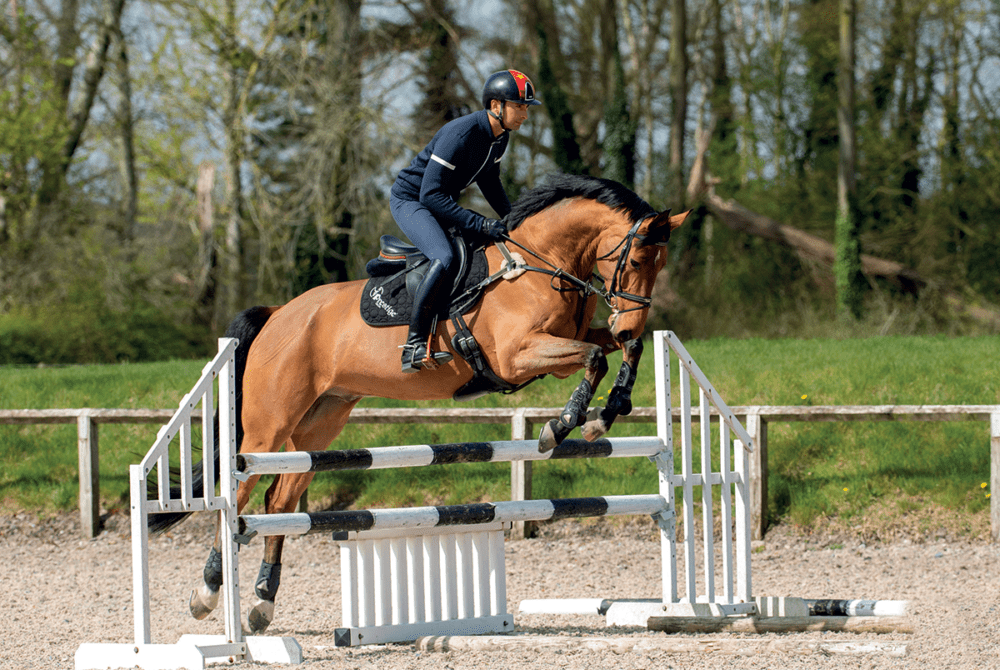Handle your horse’s enthusiasm with Alex Hua Tian
Posted 3rd November 2021
Does your horse enter the showjumping phase with too much go? Nip it in the bud with Alex Hua Tian’s simple method

If you’ve ever jumped a horse with the need for speed, you’ll know it can be a hair-raising experience. Feeling out of control on a keen horse is frustrating – and sometimes frightening – but the good news is that you can get a handle on his enthusiasm with a few easy adjustments and a simple related distance exercise that introduces some tactical but unusually-placed halt transitions.
Why’s he rushing?
Horses rush for several reasons – excitability, freshness or fear to name a few. You’ll usually see riders have one of two very understandable reactions to a rushing horse, which will either be hanging on for dear life or sitting very still while trying not to influence the horse in any way. In both scenarios, the rider’s legs are almost always off the horse’s sides, and therein lies the problem.
If you don’t feel you can apply your leg, it usually means you’re riding a sharp horse who’s especially sensitive and reactive to your leg aids. This is a tell-tale sign of a horse who doesn’t accept the leg – or one who won’t allow you to hold your legs in contact with his sides without panicking or shooting off. The effect on the rider is usually to ride like a cowboy, with your legs slung as far forward as they’ll possibly go, which is a gateway to total reliance on your rein aids to regulate speed. This gives the horse the opportunity to resist the contact and, as you’ve probably guessed by now, contributes even further to his rushing and quickly becomes a self-fulfilling prophecy.
Adapt your approach
How can you break this vicious cycle? By training your horse to accept your leg and come to a fence in a rideable rhythm. This might sound easier said than done – and it is – but you don’t need to wait until your next jumping lesson to start training these principles.
A rule of thumb within my and many other riders’ training philosophies is that you want to ride a hot horse with your legs on and a lazier one with them off. The aim of this is to make the former less sensitive to your leg and the latter more so.
On a hot horse, your brain and body intuitively tell you to keep your leg off. But throughout your warm-ups, flatwork sessions and even out hacking, you need to override this instinct. Spend time getting your horse relaxed in walk with your leg in the correct position, performing downward transitions and resisting the urge to push them forward and off – instead, make sure they’re in contact with his sides throughout. Make this a mainstay of your riding, in the school and beyond, and you’ll soon start to feel the benefits of leg acceptance, including a reduction in rushing.
Part one: Look before you leap
In the first part of this exercise, you’ll perform a halt transition on your approach to the primary fence. As ever, the key to getting it right is keeping your legs on your horse’s sides. You can split this into four straightforward parts…
- Approach Ride positively around the turn onto your line to the combination, keeping your leg on and maintaining a soft hand – even if you know your horse will rush. It’ll feel counterintuitive, but it’ll help break that leg acceptance cycle.
- Halt As your horse goes to rush, keep your legs on but ask for a halt transition. He’ll stop ideally two to three strides from the first element. You may have to apply a stronger aid than usual to get the message across to your horse, who may be confused by what you’re asking of him at first. Stick to your guns if he’s resistant – it’ll all become much easier once he learns how the exercise works.
- Wait Once you’re in halt, don’t immediately praise your horse and move on. You want him to be relaxed and obedient in the halt, accepting the leg and contact. It could take half a minute, but hold out until you feel him stop fidgeting and take a breath. Then soften your aids and praise him.
- Proceed Turn a circle, allowing your horse to walk and stretch on a loose contact until you feel any residual tension dissipate. Then, pick up canter and come again.
Pick up your copy of Winter Horse&Rider, on sale 4 November 2021, to discover how you can keep your horse under control through your jumping rounds










